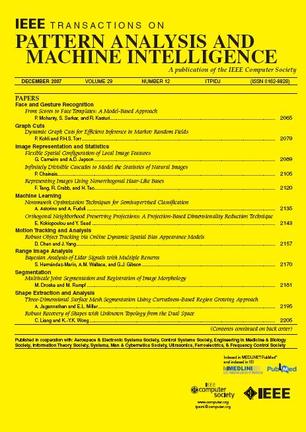An Effective Motion-Centric Paradigm for 3D Single Object Tracking in Point Clouds
IF 20.8
1区 计算机科学
Q1 COMPUTER SCIENCE, ARTIFICIAL INTELLIGENCE
IEEE Transactions on Pattern Analysis and Machine Intelligence
Pub Date : 2023-03-21
DOI:10.48550/arXiv.2303.12535
引用次数: 0
Abstract
3D single object tracking in LiDAR point clouds (LiDAR SOT) plays a crucial role in autonomous driving. Current approaches all follow the Siamese paradigm based on appearance matching. However, LiDAR point clouds are usually textureless and incomplete, which hinders effective appearance matching. Besides, previous methods greatly overlook the critical motion clues among targets. In this work, beyond 3D Siamese tracking, we introduce a motion-centric paradigm to handle LiDAR SOT from a new perspective. Following this paradigm, we propose a matching-free two-stage tracker M 2-Track. At the 1st-stage, M2-Track localizes the target within successive frames via motion transformation. Then it refines the target box through motion-assisted shape completion at the 2nd-stage. Due to the motion-centric nature, our method shows its impressive generalizability with limited training labels and provides good differentiability for end-to-end cycle training. This inspires us to explore semi-supervised LiDAR SOT by incorporating a pseudo-label-based motion augmentation and a self-supervised loss term. Under the fully-supervised setting, extensive experiments confirm that M2-Track significantly outperforms previous state-of-the-arts on three large-scale datasets while running at 57FPS ( ∼ 3%, ∼ 11% and ∼ 22% precision gains on KITTI, NuScenes, and Waymo Open Dataset respectively). While under the semi-supervised setting, our method performs on par with or even surpasses its fully-supervised counterpart using fewer than half labels from KITTI. Further analysis verifies each component's effectiveness and shows the motion-centric paradigm's promising potential for auto-labeling and unsupervised domain adaptation. The code is available at https://github.com/Ghostish/Open3DSOT.一种有效的点云中三维单目标跟踪的运动中心范式
激光雷达点云中的三维单目标跟踪在自动驾驶中起着至关重要的作用。目前的方法都遵循基于外观匹配的暹罗范式。然而,激光雷达点云通常是无纹理和不完整的,这阻碍了有效的外观匹配。此外,以往的方法严重忽略了目标间的临界运动线索。在这项工作中,除了3D连体跟踪之外,我们还引入了以运动为中心的范例,从新的角度处理LiDAR SOT。在此基础上,我们提出了一种无匹配的两阶段跟踪器m2 - track。在第一阶段,M2-Track通过运动变换在连续帧内定位目标。然后在第二阶段通过运动辅助形状完成对目标框进行细化。由于以运动为中心的性质,我们的方法在有限的训练标签下显示出令人印象深刻的泛化性,并为端到端循环训练提供了良好的可微分性。这启发我们通过结合基于伪标签的运动增强和自监督损失项来探索半监督LiDAR SOT。在完全监督的设置下,大量的实验证实,M2-Track在以57FPS运行的情况下,在三个大型数据集上的表现明显优于以前的最先进水平(分别在KITTI、NuScenes和Waymo开放数据集上的精度提高了~ 3%、~ 11%和~ 22%)。而在半监督设置下,我们的方法使用来自KITTI的不到一半的标签,其性能与完全监督的对应方法相当甚至超过。进一步的分析验证了每个组件的有效性,并显示了以运动为中心的范式在自动标记和无监督域适应方面的巨大潜力。代码可在https://github.com/Ghostish/Open3DSOT上获得。
本文章由计算机程序翻译,如有差异,请以英文原文为准。
求助全文
约1分钟内获得全文
求助全文
来源期刊
CiteScore
28.40
自引率
3.00%
发文量
885
审稿时长
8.5 months
期刊介绍:
The IEEE Transactions on Pattern Analysis and Machine Intelligence publishes articles on all traditional areas of computer vision and image understanding, all traditional areas of pattern analysis and recognition, and selected areas of machine intelligence, with a particular emphasis on machine learning for pattern analysis. Areas such as techniques for visual search, document and handwriting analysis, medical image analysis, video and image sequence analysis, content-based retrieval of image and video, face and gesture recognition and relevant specialized hardware and/or software architectures are also covered.

 求助内容:
求助内容: 应助结果提醒方式:
应助结果提醒方式:


